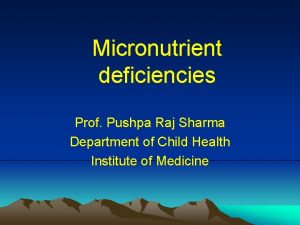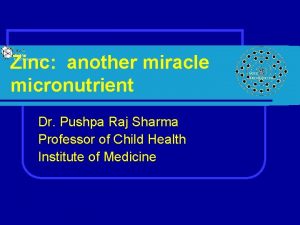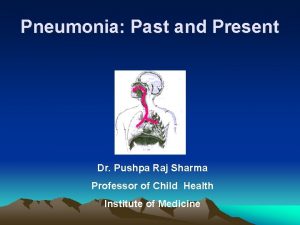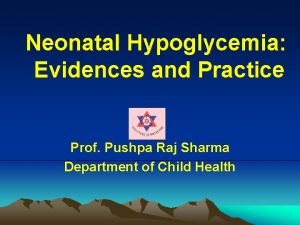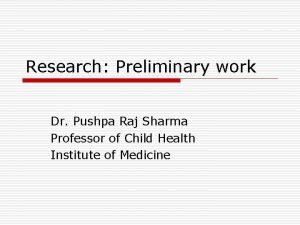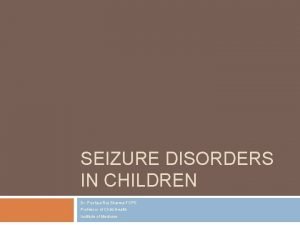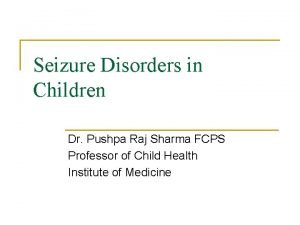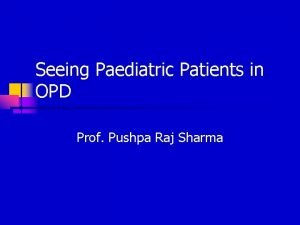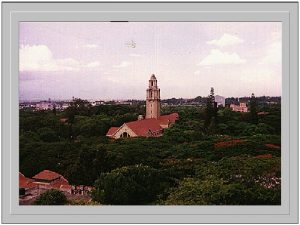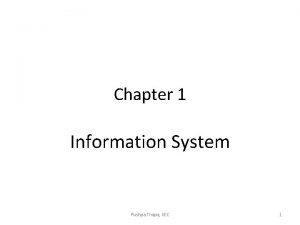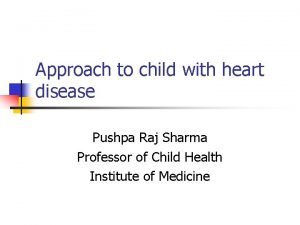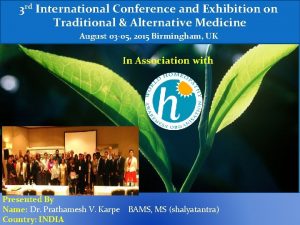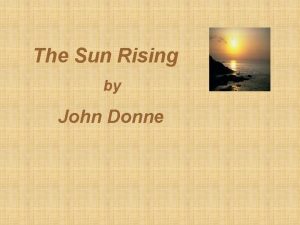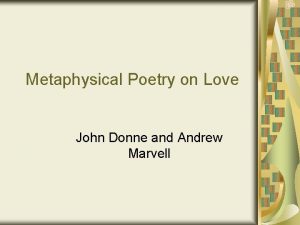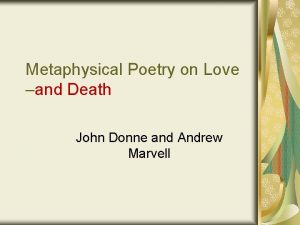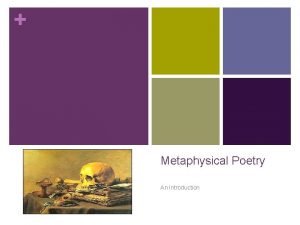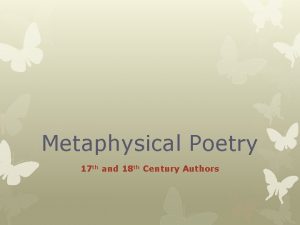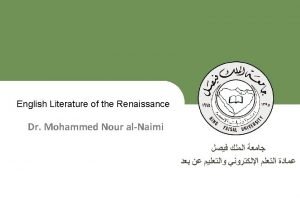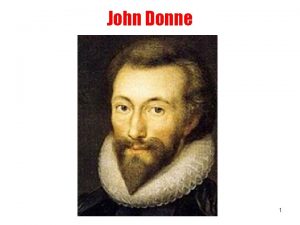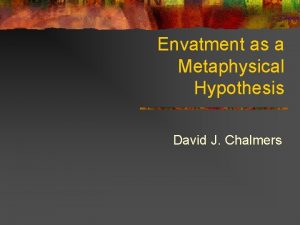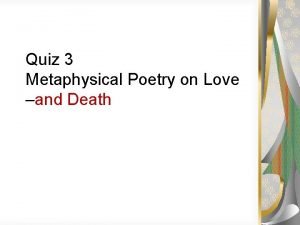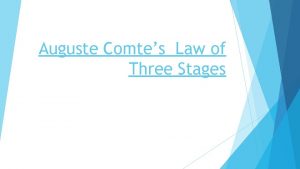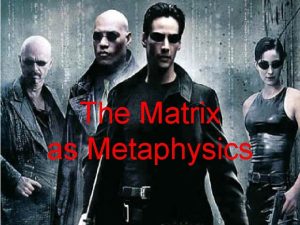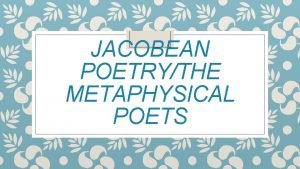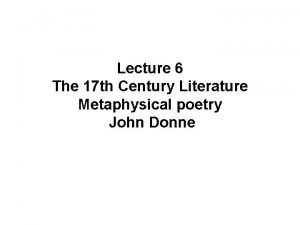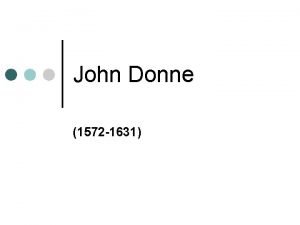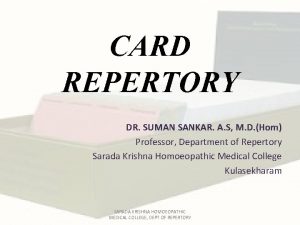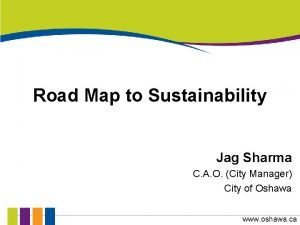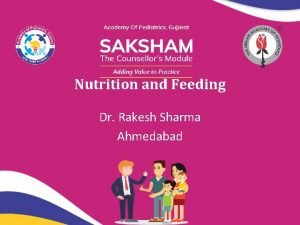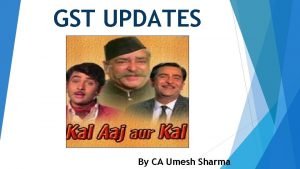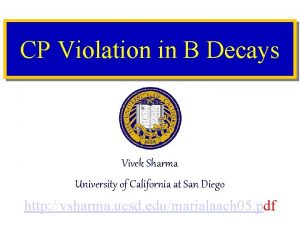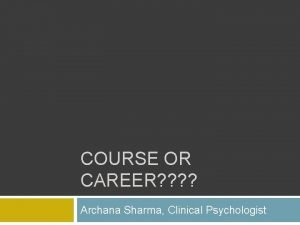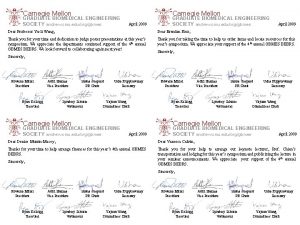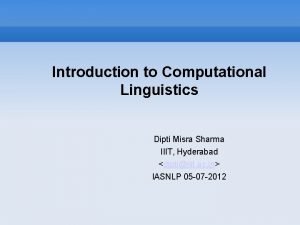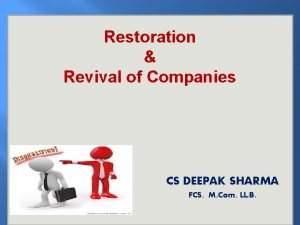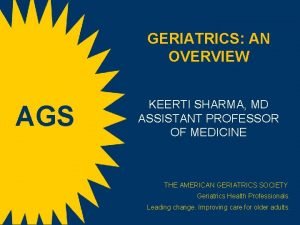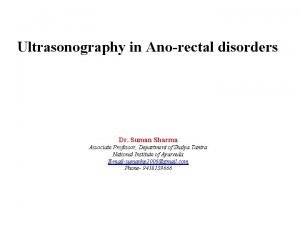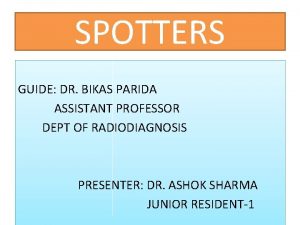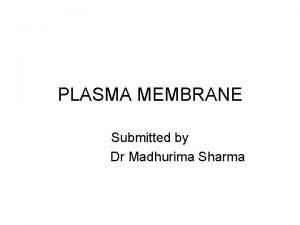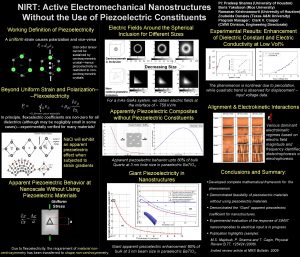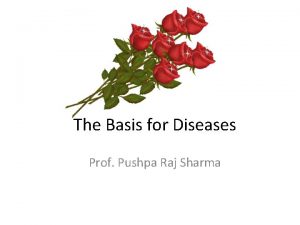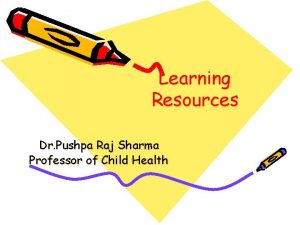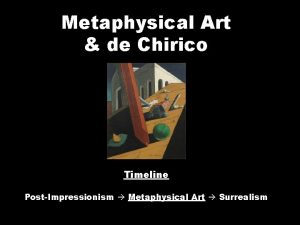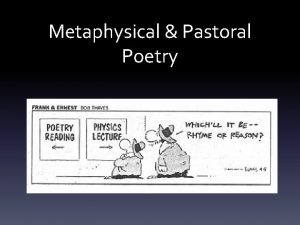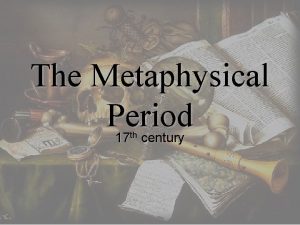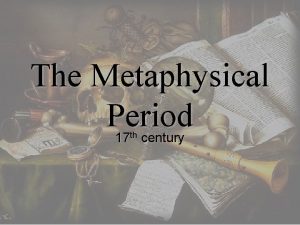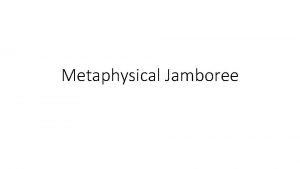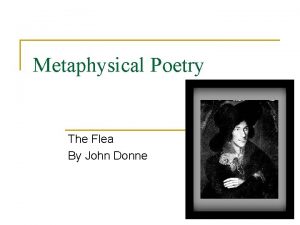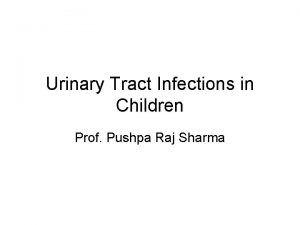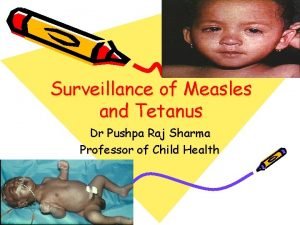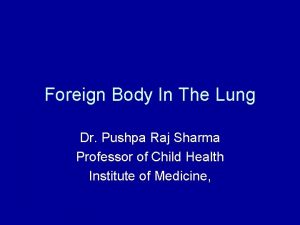Metaphysical Health Prof Pushpa Raj Sharma The first






















































- Slides: 54

Metaphysical Health Prof. Pushpa Raj Sharma

The first question…………………. . • Who am I?

The Journey………………. Oparin, Haldane, 1930’s Research into 1970’s supportive

Stanley Miller the chemical origin of life is a lot more difficult than we first imaged Father of 'Origin of Life’ Chemistry Dies May 21, 2007 National Geographic 1998

Biochemistry D. Voet & J. G. Voet Wiley 2004

Amoeba movement

Who am I? My body is created by these Pancha Mahabhut

Video spermetozoa fertilizing ovum

Physical= Body = Disease Its origin?

The physical brain for body has other dimension………… The collective conscious and unconscious processes in a sentient organism that direct and influence mental and physical behavior. The metaphysical MIND

Development of body consciousness Body Developm ent Reacts with Earth Universe (Physical) Human Cells Survival reflexes, growth of desire, anger, fear, ego Earth (Physical) Life (Physical) Body consciousness Cosmos (Metaphysical

Metaphysics is a branch of philosophy concerned with explaining the fundamental nature of being and the world. Ontology: The study of Being and existence; includes the definition and classification of entities, physical or mental, the nature of their properties, and the nature of change. • Natural Theology: The study of a Gods; involves many topics, including among others the nature of religion and the world, existence of the deivine, questions about Creation, and the numerous religious or spiritula issues that concern humankind in general. • Universal Science : The study of first principles, which Aristotle believed were the foundation of all other inquiries. An example of such a principle is the law of noncontradiction and the status it holds in non-paraconsistent logics. •

HUMAN BEING HUMUS SOIL FEAR, ANGER, ATTACHMENT, NEGATIVE ENERGY C O N S C I O U S N E S S BEING SOUL STABILITY, LOVE, PEACE, POSITIVE ENERGY

Consciousness Soul consciousness Body consciousness • Desire for experiences that provide: – – – Love Peace Happiness Truth Purity – – – Fulfilling expectations Attachment Ego Money Materials Position

Dr. Masaru Emoto's The True Power of Water: hypothesis: "Water shows different shapes of ice crystals depending on the information it has received. " "We must pay respect to water and feel love and gratitude, and receive vibrations with a positive attitude. Then, water changes, you change, and I change. Because both you and I are water. " (From the book cover. ) The Hidden Messages in Water, and his books have been published in 24 languages

Types of person • Hippocrates. This Greek physician classified or typed people using a system of four elements – air, earth, water and fire. He described people who had excessive amounts of each of these as sanguine, melancholic, phlegmatic or choleric • Ayurveda. This is also an ancient and very complex system of healing that classifies people as pitta, vatta and kapha, and combinations of these three doshas, as they are called.

• “Reduction in negative effect, tiredness, and aches and pains and increase in emotion regulation, feeling of calmness, eand self acceptance” – Broedrick. PC, Metz S. Learning to BREATHE: a pilot trial of mindfulness curriculum for adolescents. Adv School Mental Health Promot. 2009; 2: 35 -46. • “Significant decrease in systolic and diastolic blood pressures as well as blood pressure reactivity to a social stresser interview” – Barnes VA, Davis HC, Murzynowski JB, Treiber FA. Impact of meditation on resting and ambulatory blood pressure and heart rate in youth. Psychosom Med. 2004; 66: 909 -904.

• Autonomic types. Dr. Melvin Page, DDS and others, perhaps, such as William Kelley, DDS, type people by which branch of the autonomic nervous system is dominant – sympathetic or parasympathetic types. • Personality type A or Type B • Fast and slow oxidizers based on blood p. H and CO 2 levels (Dr. George Watson ). The blood of fast oxidizers tended to be slightly more acidic. He also identified another metabolic type he called sub-oxidizers. This was a group of people that did not quite fit into the fast or slow oxidizer category.

• Fast Oxidation = an Alarm Stage of Stress = a Sympathetic State of body chemistry. For example, he asserted that an alarm stage of stress (the fight-or-flight response) is a sympathetic state. It also tends to correspond to a fast oxidizer. This is not too hard to understand. All are characterized by excessive activity of the thyroid and adrenal glands and a hyper-alert state of the nervous system. •

• Slow Oxidation = Resistance or Exhaustion Stage of Stress = a more Parasympathetic state of body chemistry. As stress continues, the thyroid and adrenal glands begin to “burn out” and one goes into the resistance and exhaustion stages of stress. The oxidation rate begins to slow and the body begins to move from a sympathetic to an unhealthy parasympathetic state. The latter occurs not because one chooses it, but because the sympathetic system becomes depleted of nutrients and can no longer function correctly. As a result, the body flips into a parasympathetic state, in part to prevent further catabolism and breakdown of the body.

• Healthy parasympathetic dominant individuals: They love to relax, do not react to stress and may rest all day, not because they are tired but because they are content. • Sympathetic dominant individuals: They include compulsiveness, running around excessively, overworking, excessive thinking, fearfulness, anxiety, worry or anger. One may talk, think and work fast.

Thinking Process Environment Reflexive/ or low level processosr Memes Experi ence Cognitive Processor Senses Responses Simplified Process of Thinking

Upper and lower metaphysical neurology Atma Conscious ATMA Body Conscious INTELLECT MIND Sensory Organs ACTIONS

Ivan Pavlov’s experiment (1927)

Walter Bradford Cannon, MA, MD (1871– 1945) • When an animal is strongly aroused, the sympathetic division of its autonomic nervous system combines with the hormone adrenaline to mobilize the animal for an emergency response of “flight or fight. ” The “sympathicoadrenal system” orchestrates changes in blood supply, sugar availability, and the blood’s clotting capacity in a marshaling of resources keyed to the “violent display of energy. ” • 1915 book, Bodily Changes in Pain, Hunger, Fear and Rage. 3

Psychoneuroimmunology (PNI) In 1975 Robert Ader and Nicholas Cohen at the University of Rochester advanced PNI with their demonstration of classic conditioning of immune function, and coined the term "psychoneuroimmunology". A signal via the nervous system (taste) was affecting immune function. In 1981 David Felten, then working at the Indiana University of Medicine, discovered a network of nerves leading to blood vessels as well as cells of the immune system. In 1985, research by neuropharmacologist Candace Pert revealed that neuropeptide-specific receptors are present on the cell walls of both the brain and the immune system.

Psychoneuroimmunology (PNI) Herbert and Cohen in 1993: They found consistent stress-related increases in numbers of total white blood cells, as well as decreases in the numbers of helper T cells, suppressor T cells, and cytotoxic T cells, B cells, and Natural killer cells (NK). Herbert TB, Cohen S. Stress and immunity in humans: a meta-analytic review. Psychosom Med. 1993; 55: 364– 379

MIND: Thoughts, Emotions, Attitudes, Memories Hypothalamus Neuronal synapses Neuropeptides Cells Stress Hormones Sympathetic dominance Fight or Flight, Sadness, Lack of energy Endorphins, Enkephalins Parasympathetic dominance Feeling of wellbeing, Happiness, Pooling of energy

Endorphins • 1960 s, – "opiate receptors" in brain tissue. – biochemicals that might be synthesized in the brain itself. • 1970 s – several small peptides were isolated that apeared to possess natural analgesic properties, and these were collectively termed enkephalins and endorphins • Terenius, 1982 – Endorphins are the body's own opiate.

Endorphins • There is one stimulus, however, that makes our brains produce endorphins in larger amounts-intensive aerobic exercise (Rahkila, et al, 1988). • Endorphins make us feel good. They give us a sensation of wellness and peace, helping shrink our problems to their true dimensions. They diminish our giants, creating a euphoric effect that gives us energy, enthusiasm and power to accomplish daily tasks (Pierce, et al. , 1993). • Since endorphins are so important, what can we do to produce them? Several stimuli make our brains produce these substances, such as meditation, laughing and positive attitude (Harte, Eifert and Smith, 1995).

BMJ 2011; 342: c 7086: 10. 1136/bmj. c 7086

Development of Aatma consciousness Body Developm ent Reacts with Earth Universe (Physical) Human Cells Survival reflexes, growth of desire, anger, fear, ego Earth (Physical) Life (Physical) Body consciousness Cosmos (Metaphysical

Meditation • The word meditate stems from the Latin root meditatum, i. e. to ponder. • dhyāna in Buddhism and in Hinduism, which comes from the Sanskrit root dhyai, meaning to contemplate or meditate. • prehistoric times older civilizations used repetitive, rhythmic chants and offerings to appease the gods. • Some of the earliest written records of meditation date to 1500 BC in Hindu Vedantism. • Lekhraj started holding satsangs which attracted many people and the group became known as Om Mandali: Hyderabad, Sindh in the 1930 s • The Transcendental Meditation or TM technique is a form of mantra meditation introduced in India in 1955 Maharishi Mahesh Yogi.

The Silk Road of transmission of Buddhism introduced meditation to other oriental countries:

Types of meditation Practice • Concentration on a word, thought, sensation, or image – Transcendental meditation; relaxation response; breath-focused meditation; mantra repetition; meditation on a prayer, mandala, or other image • Mindfulness – Mindfulness-based stress reduction, Vipassana • Movement-based meditation – Yoga, tai chi, qi gong, Sufi dancing • Cultivating positive emotions (such as compassion, forgiveness, gratitude, or loving-kindness) – Buddhist metta or tonglen practices (cultivating compassion and loving-kindness), Institute of Heart. Math training (cultivating gratitude or compassion) • Emptying – Centering prayer, waiting on the inner voice or inner light

Physiologic effect in Adult • Nonmovement meditation: – Hypometabolic state: decreased heart rate, respiratory rate, skin resistance and blood pressure. – Changes in the autonomic nervous system: less sympathetic and more parasympathetic activity, lower cortisol concentration, changes associated with decreaseased stress and greater psychophysiologic cohrence,

• Greater alpha and theta coherence, increased activity of left prefrontal cortex (associated with greater happiness. • Compassion generates synchronized gamma activity. • Inhanced immune function in response to stress and immunization.

Neuroimaging, FMRI, blood flow studies: • Inhanced blood flow and thicker cortical areas in those parts of brain associated with attention and emotional regulation such as prefrontal cortex and the anterior cingulate cortex. • Regional brain activation in the dorsal lateral prefrontal cortex and anterior cingulate corex. • Increased blood flow in the right temporal lobe and posterior cingulate gyrus.

Paediatric studies • Flook (2010) Randomized control – Outcome: Improved executive function for students with lower baseline (p<0. 02), improved attention and anger management. • Biegel (2009) Randomized control trial – Outcome: reduced anxiety, depression, somatic distress, increased self esteem and sleep quality. • Sibinga (2008) No control group – Outcome: Reduced reactivity and improved self care • Bootzin (2005) No control group – Outcome: Improved sleep, decreased worry and decreased mental health distress.

Thought Pyramid Endorphin Serotonin Ultimate Positive Constructive Useless Cortisol Adrenaline Noradrenaline Negative Destructive

Purification Process: Meditation Devotion Diet Discipline If regularly used automated reflex action If not purified neuronal apoptosis

Burn Out Syndrome: 1970 Burnout has been described by Maslach and coworkers: • As a condition in which professionals “lose all concern, all emotional feeling for the people they work with, and come to treat them in a detached or even dehumanized way. ” • Professional burnout is a psychological syndrome arising in response to chronic interpersonal stressors on the job. • Burnout is a problem that is specific to the work context, in contrast to depression, which tends to pervade every domain of a person’s life. • Physical illness, emotional problems, increased turnover, absenteeism and poor job performance and negative attitudes in general.

Burn Out Syndrome

Burn Out Syndrome

Monday, October 11, 2010 NY Times For several decades now, studies have consistently shown that physicians have higher rates of suicide than the general population — 40 percent higher for male doctors and a staggering 130 percent higher for female doctors. Students enter medical school with mental health profiles similar to those of their peers but end up experiencing depression, burnout and other mental illnesses at higher rates.

Every birth can survive for 90 years Scandavian Countries

Swiss Age

Health • Hippocrates, stated something similar over 2, 000 years ago - in the 5 th century BC: "Positive health requires knowledge of man's primary constitution and the powers of various foods, both those natural to them and those resulting from human skills. But eating alone is not enough for health. There must be exercise, of which the effects must likewise be known. The combination of these two things makes regimen, when proper attention is given to the seasons of the year, the changes of the winds, the age of the individual and the situation of his home".

Disease: Any deviation from or interruption of the normal structure or function of any body part, organ, or system that is manifested by a characteristic set of symptoms and signs and whose etiology, pathology, and prognosis may be known or unknown. Health: Health is a state of complete physical, mental and social well-being and not merely the absence of disease or infirmity. (1948 WHO) An expansion of the WHO definition may be necessary to include a spiritual dimension of health if social scientists can agree that spirituality is part of health and not merely an influence. James S Larson. The World Health Organization's definition of health: Social versus spiritual health. 1996 Social Indicators Research. Volume 38, Number 2. 181 -192,

Definitions • an integral aspect of religious experience; • recognize aspects of life and human experience which are not captured by a purely materialist or mechanistic view of the world; • "spiritual" as nurturing thoughts, emotions, words and actions that are in harmony with a belief that the entire universe is, in some way, connected; • spirituality as the active connection to some force/power/energy/spirit, facilitating a sense of a deep self;

What is spirituality? • Spirituality, in a wide variety of cultural and religious concepts, is itself often seen as incorporating a spiritual path, along which one advances to achieve a given objective, such as a higher state of awareness, to become perfect human being, outreach wisdom or communion with God or with creation.

Spiritual disciplines • meditation, prayer, fasting • process in two phases: – first on inner growth, – the second on the manifestation of this result daily in the world. • "Religion is not identical with spirituality; rather religion is the form spirituality takes in civilization. " – yogi William Irwin Thompson • "Where religion ends, spirituality begins“ – -Babuji Maharaj

What you want? Bliss or Misery; Atma conscious or Body conscious. It is your choice.

 Dr pushpa raj sharma
Dr pushpa raj sharma Dr pushpa raj sharma pediatrician
Dr pushpa raj sharma pediatrician Pushpa raj sharma
Pushpa raj sharma Dr pushpa raj sharma clinic
Dr pushpa raj sharma clinic Dr pushpa raj sharma pediatrician
Dr pushpa raj sharma pediatrician Pushpa raj sharma
Pushpa raj sharma Pushpa raj sharma
Pushpa raj sharma Dr pushpa raj sharma contact number
Dr pushpa raj sharma contact number Dr pushpa raj sharma
Dr pushpa raj sharma Prof raj reddy
Prof raj reddy Humen kec distribution
Humen kec distribution Puspa wood
Puspa wood Pushpa x ray
Pushpa x ray Dr pushpa gross
Dr pushpa gross Shukrashmari
Shukrashmari Dr pushpa gross
Dr pushpa gross Sun rising as a metaphysical poem
Sun rising as a metaphysical poem Albatross (metaphor)
Albatross (metaphor) John donne introduction
John donne introduction John donne carpe diem
John donne carpe diem Define metaphysical poetry
Define metaphysical poetry Define metaphysical poetry
Define metaphysical poetry Batter my heart mcq
Batter my heart mcq A valediction forbidding mourning by john donne
A valediction forbidding mourning by john donne Metaphysical poetry characteristics
Metaphysical poetry characteristics Brain in a vat
Brain in a vat Metaphysical poetry quiz
Metaphysical poetry quiz Law of three stages by auguste comte
Law of three stages by auguste comte Metaphysical hypothesis examples
Metaphysical hypothesis examples Metaphysical poets focused on _____.
Metaphysical poets focused on _____. Jacobean priest and metaphysical poet
Jacobean priest and metaphysical poet Jacobean and caroline age
Jacobean and caroline age Go and catch a falling star as a metaphysical poem
Go and catch a falling star as a metaphysical poem John donne poem
John donne poem John donne as a metaphysical poet
John donne as a metaphysical poet Modern concept of paediatric nursing
Modern concept of paediatric nursing Kishore card repertory image
Kishore card repertory image Consonant examples
Consonant examples Jag sharma
Jag sharma Dr rakesh sharma ahmedabad
Dr rakesh sharma ahmedabad Ca umesh sharma
Ca umesh sharma Pawan sharma bits pilani
Pawan sharma bits pilani Dr vivek sharma
Dr vivek sharma Dr archana sharma psychologist
Dr archana sharma psychologist Aditi sharma cmu
Aditi sharma cmu Dipti mishra iiit hyderabad
Dipti mishra iiit hyderabad Gaurav sharma cisco
Gaurav sharma cisco Cs deepak sharma
Cs deepak sharma Keerti sharma md
Keerti sharma md Amrit sharma morgan stanley
Amrit sharma morgan stanley Dr suman sharma
Dr suman sharma Dr bikas sharma
Dr bikas sharma Dr madhurima sharma
Dr madhurima sharma Dr pk sharma
Dr pk sharma Pradeep sharma university of houston
Pradeep sharma university of houston
